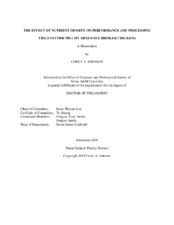| dc.description.abstract | The objective of this research program was to determine the dietary amino acid and energy density required to optimize performance and yield in the Cobb 700 × MV broiler in a series of 4 experiments. Experiment one consisted of 2 × 3 factorial design with a high or low level of apparent metabolizable energy (AME) and a low, medium, or high level of digestible essential amino acid density (dEAA). Broiler performance was incrementally improved with increasing dEAA and AME. Increasing dEAA increased breast fillet and tenderloin yield and reduced fat pad yield. Feeding the high AME diet reduced feed intake and increased fat pad yield leading to a reduction in breast meat yield. No treatment interactions were observed, suggesting that the low level of AME was adequate to support increased muscle accretion. Experiment two consisted of five dietary treatments: a control (CON) and a CON plus 5%, 10%, 15%, or 20% of dEAA. Broiler performance was improved with each stepwise increase in dEAA. Feeding the 20% treatment led to the greatest increase in breast fillet yield and decrease in fat pad yield. Regression analysis confirmed a positive linear relationship with digestible lysine intake and total breast meat yield. A breakpoint in breast meat yield response was not observed, suggesting that yield may be improved further with a dEAA above +20%.
Experiment three and four consisted of two identically designed experiments, each utilizing the same seven dietary treatments: a low (L), medium (M), or high (H) dEAA during the starter phase followed by a L, M, H, or High + (H+) dEAA during the grower, finisher, and withdrawal phases. Increasing dEAA improved performance and led to incremental increases in breast fillet and tenderloin yield and decreases in fat pad yield. Additionally, increasing dEAA from 0-12 d increased breast meat yield at harvest irrespective of the density fed from 12-49 d. In totality, these data demonstrate the beneficial impact of increasing dEAA on Cobb 700 x MV broiler performance and yield and define expected improvements associated with these increases, allowing producers to conduct economic evaluations to determine their most profitable nutrient density. | en |


